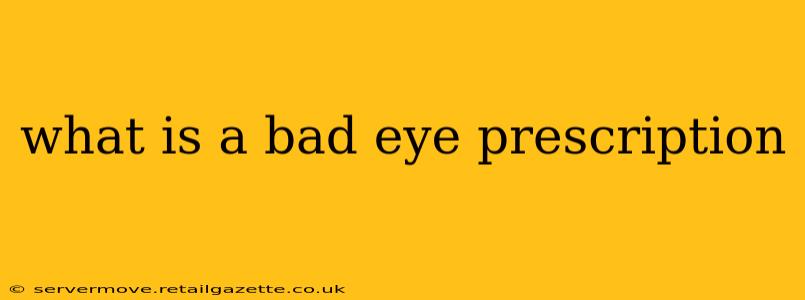What is Considered a "Bad" Eye Prescription?
The term "bad" eye prescription is subjective and doesn't have a universally agreed-upon definition. What constitutes a "bad" prescription depends on several factors, and simply having a high number isn't the sole indicator. A more accurate way to think about it is understanding what constitutes a prescription requiring significant correction and the potential implications.
Instead of focusing on a "bad" prescription, it's more helpful to understand the different aspects of an eyeglass prescription and what higher numbers or stronger corrections might indicate.
What are the numbers in an eyeglass prescription?
Your prescription contains several key numbers representing different aspects of your vision:
-
Sphere (SPH): This corrects for nearsightedness (myopia) or farsightedness (hyperopia). A higher number (positive or negative) indicates a stronger correction needed. For example, -6.00 SPH indicates a significant degree of nearsightedness.
-
Cylinder (CYL): This corrects for astigmatism, an imperfection in the cornea's shape. A higher cylinder number indicates a greater degree of astigmatism requiring correction.
-
Axis: This number works in conjunction with the cylinder and specifies the orientation of the astigmatism.
-
Add: This number is only present in bifocal or progressive lenses and indicates the magnification added for near vision.
What constitutes a high prescription requiring significant correction?
Generally, prescriptions with a high sphere power (above -6.00 or +6.00) or a high cylinder power (above -2.00 or +2.00) are considered to be higher prescriptions. These might be associated with certain challenges:
-
Increased risk of certain eye conditions: High myopia (nearsightedness) is linked to an increased risk of conditions like retinal detachment, glaucoma, and cataracts.
-
Difficulty finding suitable frames: Finding appropriately sized and aesthetically pleasing frames for very strong prescriptions can sometimes be more challenging.
-
Thicker lenses: Higher prescriptions usually result in thicker and heavier lenses, potentially impacting the appearance and comfort of the glasses.
-
More pronounced visual distortion: Stronger corrections sometimes result in more noticeable distortion around the edges of the lenses, especially in lower-cost lenses.
How do I know if my prescription is "bad"?
You don't determine if your prescription is "bad" on your own. Always consult your ophthalmologist or optometrist. They are the experts who can accurately assess your vision, diagnose any underlying conditions, and provide the appropriate prescription. They can explain the specifics of your prescription and address any concerns you may have. They will also monitor your prescription over time to detect any changes and provide necessary adjustments.
What if I have a high prescription?
Having a high prescription doesn't automatically equate to "bad" vision. With the correct lenses, you can still achieve excellent vision. The key is regular eye exams, proper lens selection, and communication with your eye care professional to manage any associated risks.
What are the symptoms of needing a stronger prescription?
Symptoms of needing a stronger prescription might include:
- Blurred vision at any distance.
- Eye strain.
- Headaches.
- Difficulty focusing.
- Squinting.
Remember, regular eye exams are crucial for maintaining good eye health and ensuring your prescription is accurate and up-to-date. Don't hesitate to discuss any concerns you have with your eye care professional. They can provide personalized advice and guidance.
